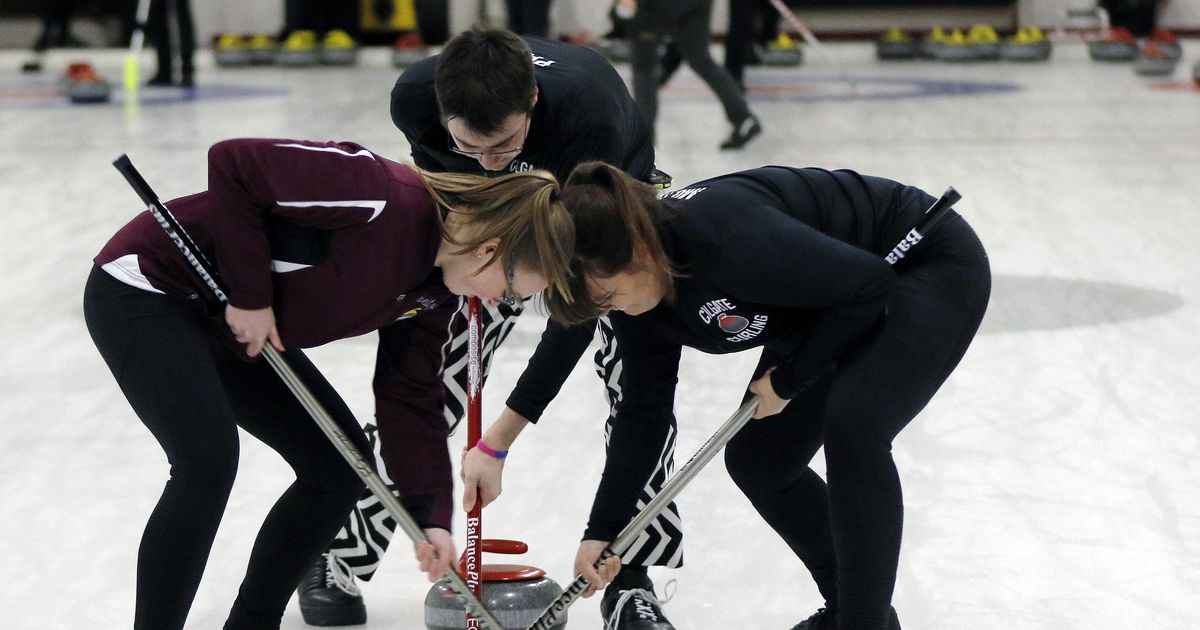As curling grows, it finds a new target: college campuses


WAYLAND, Mass. (AP) — Harvard sophomore Jack Schroeder has modest expectations for the prestige and fortune that might await him across the river if the Crimson manage to win the college curling national championships outside of Boston this weekend.
With a victory, Schroeder has been promised an extension on his government midterm that would otherwise be due on Wednesday.
Otherwise, he said, he wouldn’t expect much of a reception at all.
“It could probably boost curling’s credibility across campus,” Schroeder said on Friday as round-robin play in the tournament began. “I think if we told people, they’d probably be pretty impressed.”
Far removed from basketball’s March Madness or even hockey’s Frozen Four, the college curling championship is quietly taking place at the Broomstones Curling Club in this Boston suburb, with the nation’s top 16 teams competing in front of friends and family and an audience of unknown size on the USA Curling internet feed.
Unlike the more hyped NCAA tournaments, with their sponsors and scholarships and pathway to the pros, the curling championship features mainly self-funded clubs of various skill levels and support from their schools.
But for the event’s organizers, it’s a step toward building a prolonged, nationwide following from what so far has typically been a temporary Olympic bounce.
“The college championships are more about participation and growth than elite competition,” said Rick Patzke, the CEO of USA Curling, which now sanctions what had long been a more informal collegiate tournament.
“College students are being exposed to something they might not have ever been exposed to before,” Patzke said. “They may not become an immediate, lifelong curler. But they might come back to it later in life when they’re looking for something to do.”
A 500-year-old Scottish sport that is also popular in Canada and Scandinavia, American curling has some hotbeds in Wisconsin and Minnesota, where children grow up sliding rocks much like Texans take to football or Californians learn to surf.
Elsewhere, the sport seems to appear on television sets every Winter Olympics and then just as quickly fade from view.
But with the first-ever American gold medal in curling in Pyeongchang last year, the sport’s boosters are hoping for more than the usual short-term bump in popularity.
“It’d be great if it continue to go that direction,” said Tyler George, a member of the Olympic championship team, who has since taken time off from competing to serve as an ambassador for the sport. “Exposure is the key.”
That’s where the college championship fits in.
Gordon Maclean, the chair of the U.S. Curling Association’s college committee, said Americans often age out of junior programs at the age of 18 with nowhere to go next.
“We’ve got a gap in our demographics,” he said on Friday as pool play for the tournament began. “We were losing curlers during the college years. And this program has switched that around entirely. We’re not losing players now, we’re gaining players.”
Curling has had a college championship since at least the 1990s, but the tournament in Chicago drew almost exclusively teams from northern Illinois and Wisconsin and it was a stretch to declare the winner a true national champion. Before USA Curling asked Maclean to see what he could do with the event in 2012, it was still accepting any team willing to make the trip.
“There’s no other sport where you say ‘sign up and go to the championships,’” Maclean said. “I mean, imagine basketball if it was sign up and go. You wouldn’t have near the interest, and it would be not nearly as legitimate, either.”
Now, schools qualify by earning points in regional bonspiels, or tournaments. From three or four events the first year, the system grew to 15 last year; Maclean has already fielded calls from clubs in Texas and in Fort Wayne, Indiana, where Purdue and Notre Dame want to co-host an event next year.
“I wish that would’ve been around when I was in school,” George said.
In all, 370 students from 35 schools — men and women, graduate student and undergrad, all competing together — participated in sanctioned events this season, up 25 percent from two years ago. Maclean is hoping for expansion in spots with existing curling facilities and several schools in the area, like North Carolina’s Research Triangle.
“We’re on the growth curve now in terms of participating students and participating schools,” he said. “So I think it’s legitimate to say we’ve got a formula that works.”
A big part of that growth is credited to the Olympics, when TV viewers see the sweeping and the shouting and think, “Hey, I can do that.” In addition to schools in Minnesota and Wisconsin, where students might have grown up curling with their families, the sport sometimes known as “chess on ice” is also taking root in the Ivy League and other elite academic institutions.
“A quarter of the schools here have the word ‘technology’ somewhere in their name,” Maclean said, noting that the strategic aspect of the game is as important as the skill in throwing rocks. At the recent MIT Sloan Sports Analytics Conference, an entire panel was devoted to curling analytics.
“It’s kind of a geek sport,” Maclean said. “I mean, I might not fit in on a basketball court or a volleyball court or in a swimming pool, but I can go out here and slide on the ice with a relatively little amount of training and be fairly legitimate at it.”
The gap between teams was apparent this weekend, with some players of evident skill and less-experienced competitors easily identified by the use of the “curling crutch,” a PVC contraption that helps with a player’s balance when he slides.
Some teams had warmup jackets with their school crests or logos; others wore matching T-shirts; some didn’t match at all. Maclean said some teams pay for ice time and transportation to bonspiels through a combination of player (or parent) contributions and fundraisers, and the lucky ones are subsidized by their schools.
For now, there are no varsity curling teams in the country. Nor do any schools grant scholarships in the sport. No schools have coaches on their staff or own their own facilities, Maclean said.
“That’s the dream. That’s something we’d like to see happen,” George said. “But baby steps right now.”







